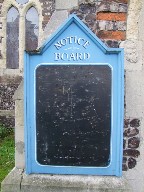| |
|
St John,
Great Yarmouth This extraordinary structure, a short walk
from Great Yarmouth's jolly sea front, with the terraces
of bedsit land spreading to south and west, is the best
example in Norfolk of an ecclesiastical village, the
ultimate fruit of the Tractarian movement's desire for a
return to the medieval monastic vision of the Church as a
ritualist space, a place of teaching, of residency and of
hospitality, all on one site. From the 1840s onwards this
theory of architecture would be propounded, most notably
by Pugin, but it would come to its ultimate expression at
the end of the century, ironically with the
non-conformists, who would built an agglomeration of
church, school, hall and manse shoe-horned on to a single
site in hundreds of places all over England.
St John
was, at heart, the 1850s work of JH Hakewill, whose less
competent brother EC Hakewill is more familiar in East
Anglia from his dozens of gloomy restorations. In this
poor area it was intended as a church for fishermen and
their families, perhaps the children of the fishermen
that Dickens knew and brought to life in the pages of David
Copperfield. This would have been the Peggoty
family's parish. The church was then extended to west and
north by a number of other minor architects in the
subsequent decades. Best of all is Bottle & Olley's
hexagonal vestry of the 1880s in the style of a chapter
house, wedged into the most easterly point of the site.
| Bill
Wilson, writing in the revised Pevsner, observes
that this is a very odd, not very attractive
group, but I am afraid that I think he is
quite wrong. This huddle of oddly-shaped
structures under their tower, turret and chimney,
looking correctly as if they are a group of
buildings which have accumulated over time for a
variety of purposes, is exactly as it should be,
and the Disneyland jauntiness of the whole is
perfect for the seaside. I had
wanted to see inside St John for a long time, and
I was excited to note that it was on the
participant list for the 2010 Historic Churches
Bike Ride. It was something of a disappointment,
therefore, to arrive at the church to discover
that not only was St John not taking part, but
that it had actually been declared redundant and
abandoned several months previously. I am under
the impression that some alternative use is
planned by the joint parish of Great Yarmouth,
and indeed this grouping could be a fabulous
resource for them . I will keep an eye on
developments. A part of me is rather glad that
there is a recession on, otherwise one can
imagine the rapacious property developers rubbing
their hands at the prospect of turning this into
apartments. Mind you, if they did, I wouldn't
mind living in that chapter house.
|
|
 |
|
|
|
